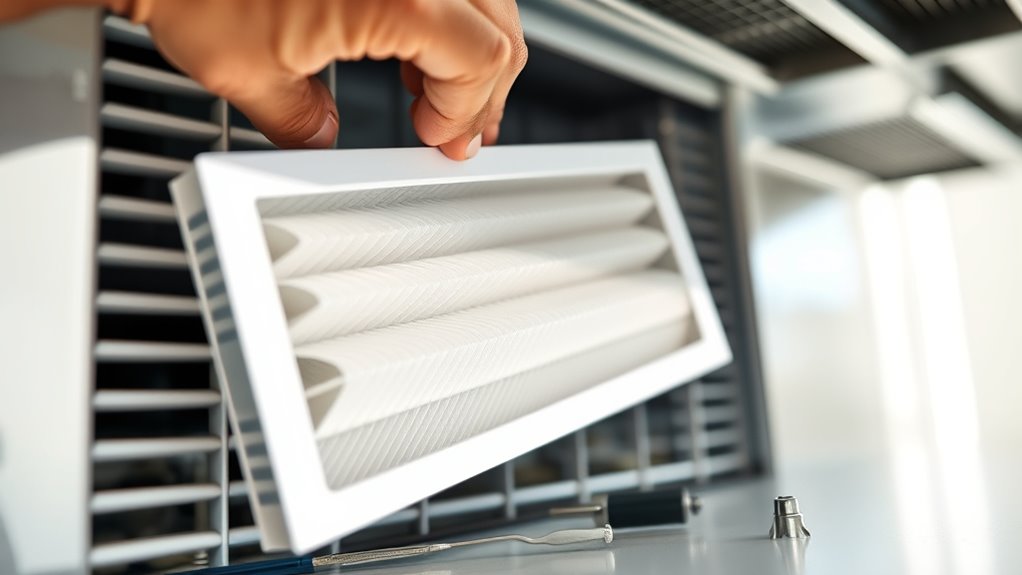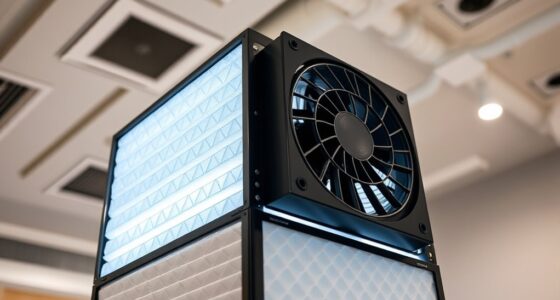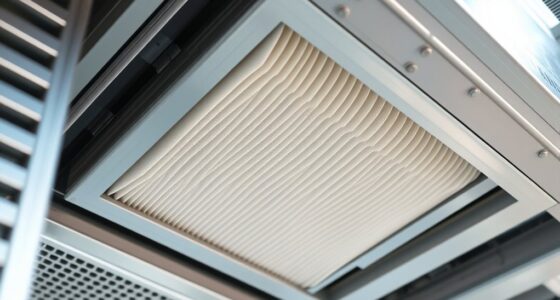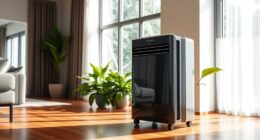Upgrading from MERV 8 to MERV 13 filters enhances your indoor air quality by capturing smaller particles like bacteria, mold spores, pet dander, and dust that standard filters miss. While MERV 13 filters provide better air filtration, verify your system can handle the denser media to prevent airflow issues. Regular maintenance and timely replacements are key to maintaining your system’s efficiency and reaping these benefits. Keep exploring to learn how to maximize your HVAC upgrade effectively.
Key Takeaways
- Upgrading from MERV 8 to MERV 13 enhances indoor air quality by trapping smaller pollutants like bacteria and mold spores.
- Ensure your HVAC system can handle the denser MERV 13 filters to prevent airflow restrictions or system damage.
- Regularly replace MERV 13 filters every 1-3 months for optimal performance and air cleanliness.
- Verify system compatibility and consider professional assessment for proper installation and system adjustments.
- The upgrade promotes healthier indoor environments, improved system efficiency, and long-term indoor air quality benefits.
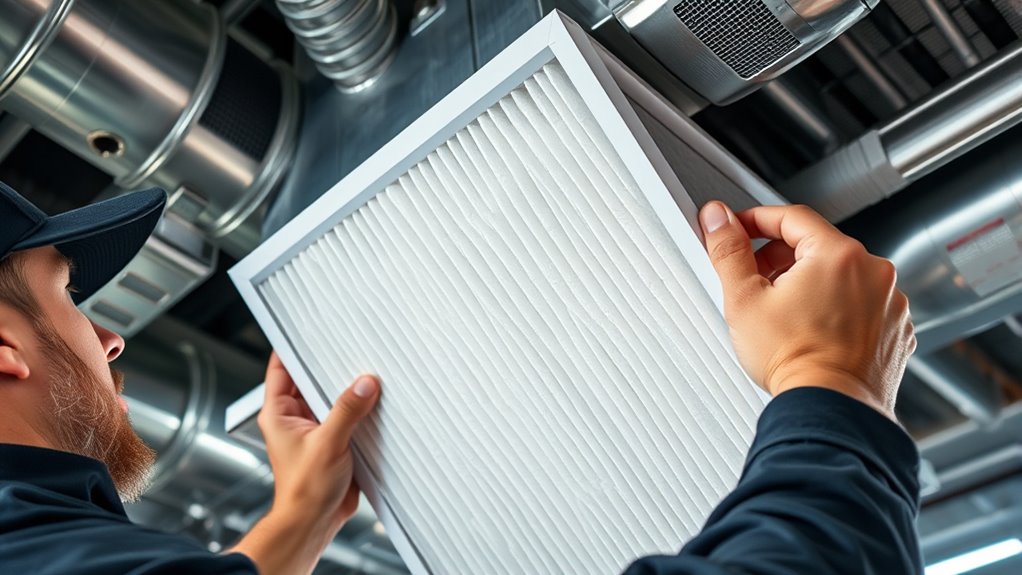
Upgrading your HVAC filtration system is a smart move to improve indoor air quality and protect your health. When you choose a higher-grade filter, like moving from MERV 8 to MERV 13, you’re actively reducing airborne pollutants, allergens, and particles that can compromise your well-being. A cleaner filter not only captures more contaminants but also contributes to better overall air quality in your home or office. However, it’s vital to stay on top of filter maintenance to guarantee your upgraded system performs at its best. Regularly checking and replacing filters prevents dust buildup and maintains airflow, which is essential for continued air quality improvements and system efficiency.
Switching to a MERV 13 filter means you’ll be filtering out much smaller particles, including bacteria, mold spores, pet dander, and fine dust. These particles often evade lower-grade filters, but a MERV 13 can trap them effectively. This upgrade can greatly benefit individuals with allergies, asthma, or respiratory sensitivities by reducing triggers and improving breathing comfort. But remember, these higher-rated filters tend to have denser media, which can slightly restrict airflow if your system isn’t designed for it. That’s why filter maintenance becomes even more critical—regular replacement ensures your system doesn’t become overburdened, preventing potential strain or damage.
Upgrading to a MERV 13 filter traps smaller particles, but regular maintenance prevents airflow restrictions and system strain.
When you switch to a MERV 13 filter, you should also pay attention to filter lifespan. While a standard MERV 8 might last three to six months, a MERV 13 may need replacement every one to three months, especially if your household has pets or high occupancy. Regular inspections and prompt replacements keep your air quality high and prevent airflow issues. Neglecting filter maintenance can lead to decreased efficiency, increased energy costs, and a decline in indoor air quality. So, set reminders or mark your calendar to check your filters regularly—this simple step guarantees your upgrade delivers the full benefits.
Additionally, upgrading your filter requires verifying that your HVAC system can handle the increased filtration density. Some systems may need adjustments or professional assessments to accommodate a MERV 13 filter without sacrificing airflow. Ensuring your system is compatible with higher-grade filters can help avoid potential performance issues and maximize filtration benefits. Once installed properly, you’ll notice that your system runs smoothly, and your indoor environment feels fresher and healthier. Remember, a high-quality filter isn’t a one-time fix; ongoing filter maintenance is key to maintaining the improved air quality you’ve worked towards. With proper care, your upgraded filtration system will serve you well, providing cleaner air and healthier living spaces for years to come.
Frequently Asked Questions
How Often Should MERV 13 Filters Be Replaced?
You should replace your MERV 13 filters every 6 to 12 months, depending on your home’s air quality and usage. Keep an eye on the filter’s lifespan and follow a regular replacement schedule to guarantee maximum airflow and air quality. If you notice reduced airflow or increased dust, it’s a sign to change the filter sooner. Regular replacements help maintain efficient HVAC performance and healthier indoor air.
Do Higher MERV Ratings Impact HVAC Energy Consumption?
Higher MERV ratings can slightly influence your HVAC system’s energy efficiency because they increase airflow resistance. You might notice your system working a bit harder to push air through the denser filters, which can lead to increased energy consumption. However, if you maintain your filters properly and ensure your system is well-tuned, the impact stays minimal. Overall, upgrading filters balances cleaner air with efficient operation.
Are MERV 13 Filters Suitable for Residential Systems?
Yes, MERV 13 filters can be suitable for residential systems if they’re compatible with your HVAC unit. However, you should check for airflow restrictions, as higher-rated filters can reduce airflow if your system isn’t designed for them. verify filter compatibility by consulting your system’s manufacturer or a professional, and consider whether your system can handle the increased filter density without compromising performance or energy efficiency.
Can Upgrading Filters Improve Allergen Removal Significantly?
Upgrading your filters can ensure improved air quality by capturing more allergens like pollen, dust, and pet dander. MERV 13 filters are more effective than lower-rated ones, helping you breathe easier and reduce allergy symptoms. Keep in mind, they may slightly reduce filter lifespan and strain your system if not compatible. Regularly checking and replacing filters guarantees optimal performance and sustained air quality benefits.
What Are the Installation Requirements for Higher-Grade Filters?
You need to check the installation considerations, such as ensuring your HVAC system can handle higher-grade filters like MERV 13. Compatibility requirements include verifying the filter slot size and the system’s airflow capacity. It is crucial to consult your system’s manufacturer guidelines to avoid airflow restrictions or damage. Properly installing the filter, ensuring a snug fit without gaps, maximizes effectiveness and maintains system efficiency.
Conclusion
Upgrading your HVAC filters from MERV 8 to MERV 13 might seem like overkill, but hey, who doesn’t want to breathe like they’re in a high-tech lab? Sure, it’s a small investment for cleaner air and fewer allergy attacks—plus, you get to feel like a health-conscious hero every time you change the filter. So go ahead, splurge a little; after all, your lungs deserve the VIP treatment, right?
